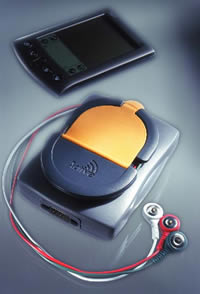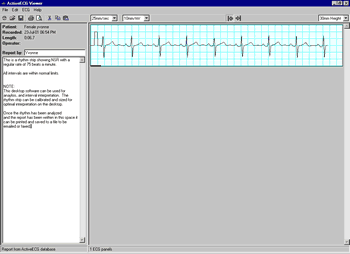|
ActiveECG
review, page 4: Mobile
Monitoring Marvel
|
 |
In clinical research, in education, in homecare and for
all the healthcare professionals who appreciates the functionality
of a Palm OS handheld device, ActiveECG is a boon to mobile
monitoring at the point of care.
|
Homecare Application of ActiveECG:
Jeneane A. Brian, BSN, MBA, CEO, VNAHHS trialed ActiveECG in discharged
post-op Coronary Artery Bypass Graft (CABG) patients in their own
home. Ms Brian reports that the length of stay (LOS) in hospital
for these open-heart patients has been reduced in recent years.
These patients receive routine cardiac monitoring for a shorter
period of time as a result of earlier discharge.
Routine cardiac monitoring in the hospital usually means continuous
3 lead cardiac monitoring for abnormal rhythms. If a significant
cardiac rhythm is detected a 12 lead ECG is usually performed to
facilitate diagnosis and a treatment plan.
When the visiting nurses assess the post-op CABG patients in the
home they can perform a 3 lead ECG using ActiveECG. ActiveECG monitors
the heart's rhythm in real time, allowing the nurse to evaluate
the rhythm on the spot, record a rhythm strip and store it on the
handheld to be loaded onto the PC/laptop for interpretation.

click
to enlarge
If the nurse detects an abnormality these findings can be reported
to a cardiologist from the patient's home.
Ms Brian says that their lead cardiologist is thrilled that the
visiting nurses are able to take a rhythm strip daily until the
first post-op office visit, which is typically one week after discharge.
The cardiologist believes the daily cardiac monitoring provides
important information and early detection of rhythm problems which
can be treated with medication, potentially avoiding invasive procedures
or re-hospitalization for the patient.
Ms Brian reports that many clinicians would like to receive 12
lead reports instead of 3 lead ECG reports. Although a 12 lead ActiveECG
machine would be a welcome addition to the 3 lead ActiveECG for
more in-depth interpretation of abnormal cardiac rhythms I suspect
that the 3 lead device is the appropriate monitoring and diagnostic
tool for the majority of CABG patients who are seen by the visiting
nurse.
Clinical Trial Application of ActiveECG:
The portability of ActiveECG makes it a good choice for use in
clinical trials. I have used a much larger portable 12 lead ECG
machine in a clinical trial. One of the drawbacks to this machine
was the fact that I couldn't see the patient's waveform. The machine
stored the waveform and sent it via modem to a central location.
I would dial the phone and provide my site details to the person
on the other end of the phone and then transmit the waveform. At
the end of the transmission the person at the other end of the phone
would report the quality of the waveform to me. It would either
be acceptable or I would have to do it again. This was both time
consuming and cumbersome. Perhaps not being able to see the waveform
was the price of getting a 12 lead ECG into a box the size of a
regular tissue box.
Another drawback was that the ECG report would be faxed back to
the site after interpretation by a cardiologist, for the study investigator
to review. The quality of the fax was often poor and made assessment
of the cardiologist's findings difficult. Meanwhile we would wait
for the hard copy to arrive by mail. The machine was capable of
storing only one ECG at a time. I would have to purge the previous
waveform before I could take another. Being able to store waveforms
in real time would have allowed the study investigator to review
the waveform within hours after it was obtained rather than having
to wait several days for the hard copy to arrive by mail.
The ActiveECG is about 1/10th the size of the tissue box and uses
the handheld device to display the waveform. The storage and displaying
capabilities are limited only by the available memory on the handheld
device. Portability and functionality are very important considerations
in clinical trials. Smaller and lighter pieces of equipment are
easier to lug around and much appreciated by the research nurse
who is always on the move.
Not all study-related ECGs need to be 12 lead; the need would be
study-dependent. ActiveECG is well-suited to the study that requires
3 lead ECGs. It is perfect for clinical trials employing handheld
devices for electronic data capture and transmission. The combination
of handheld & ActiveECG clearly demonstrates the enormous potential
of mobile computing in a clinical trial.
The ability to get a waveform without the patient having to remove
their clothing or being exposed is very appealing to the patient
and well received in the outpatient setting. I introduced the ActiveECG
to participants in a study in which I am currently involved. The
ECG is unrelated to this study but it gave me the opportunity to
get feedback from the participants. The women in this study were
very appreciative of the fact that they did not have to remove their
top and that I was not fumbling around their chest trying to place
the leads under their clothing! The size of the device is definitely
a plus; it seems to be less intimidating than the more familiar
ECG machines. The ActiveECG is both patient and user friendly.
A 12 lead ActiveECG would be welcome and useful in some circumstances,
however the 3 lead ActiveECG will provide more than adequate monitoring
and interpretation of cardiac rhythms in the majority of cases.
Patients with abnormal rhythms can always be referred for a 12 lead
and follow-up by a cardiologist based on the findings of the 3 lead
ECG obtained in the field.
ActiveECG will assist the clinician to determine the need for a
12 lead ECG. This device has huge potential for homecare, outpatient
clinics, family practice offices, and clinical trials by providing
the patient and the clinician with relevant information instantly
and in the palm of their hand. It is most useful in these settings
as a portable and practical monitoring and diagnostic tool.
ActiveECG and the Educator.
As an educator I can see the utility of ActiveECG in a rhythm interpretation
course. When I learned rhythm interpretation (too many years ago
to mention) the instructor had overheads of photocopies of actual
3 lead rhythm strips taken from ICU and CCU patients. These were
frequently of poor quality and made interpretation frustrating for
the novice.
Now imagine you are in a modern classroom with a laptop, a multi-media
projector, a document camera, your Palm OS handheld and your ActiveECG.
On your laptop you have several aberrant rhythm strips and you obtain
some rhythm strips from volunteers in the class for comparison.
Using the ActiveECG you can project the volunteer's rhythm in realtime
onto the screen. Then you can upload it to the laptop. Using the
ActiveECG software you can re-size and calibrate all of the rhythm
strips that are projected onto the screen as you demonstrate interval
measurement and interpretation of aberrant and normal rhythm strips.
The ActiveECG software will project a distinct rhythm strip onto
a clear graph that will make interval measurement and analysis a
snap and enhance the education and learning process for the novice!
Summary
Hardware:
- Easy to transport, it weighs only 6.7 oz
- It's high impact plastic casing makes it rugged, durable and
easy to clean
- Easy to use. There are no buttons or switches - everything is
controlled from your handheld
- 3 lead ECG for assessing dysrhythmias.
- A single Lithium battery powers the unit for 6 months or more
of heavy use.
- A low battery warning notifies you approximately 2 weeks before
a replacement is required
Software:
- Easy to install on your handheld and desktop.
- Ability to view cardiac rhythm in real time on the handheld,
- You can archive strips on your PC/laptop for later viewing.
Where you can analyze and annotate.
- The waveform can be resized on the PC/laptop to facilitate easy
rhythm interpretation.
- The rhythm strips display on graph paper and can be printed
for interval measurement.
Editor PDA cortex
|
|
ActiveECG review page: 1
2 3
4 |
.gif) |
.gif)
|

![]()


